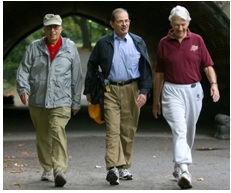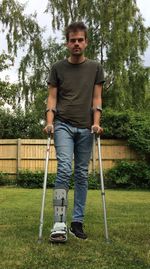Weight bearing: Difference between revisions
Rachael Lowe (talk | contribs) mNo edit summary |
Karen Wilson (talk | contribs) (order and content) |
||
| Line 1: | Line 1: | ||
<div class="editorbox"> '''Original Editor '''- [[User:Claire Knott|Claire Knott]] '''Top Contributors''' - {{Special:Contributors/{{FULLPAGENAME}}}}</div> | <div class="editorbox"> '''Original Editor '''- [[User:Claire Knott|Claire Knott]] '''Top Contributors''' - {{Special:Contributors/{{FULLPAGENAME}}}}</div> | ||
== | ==Introduction== | ||
[[File:Dementia Walking Picture.jpg|right|frameless]]In orthopaedics weight bearing refers to how much weight | [[File:Dementia Walking Picture.jpg|right|frameless]]In orthopaedics, weight bearing refers to how much weight a person puts through an injured body part. . During single leg [[Gait|stance]], an ambulatory person with no physical limitations will carry 100% of their body weight through each leg. Thus, grades of weight bearing are generally expressed as a percent or portion of this number. The concept of prescribing weight bearing restrictions applies to surgeries, joint dislocations, tendon or ligament tears/ruptures, and fractures affecting weight bearing structures of the upper and lower extremities. | ||
The surgeon or treating physician is responsible for prescribing an appropriate weight bearing status. Adherence to these restrictions is vital for optimal recovery, as premature weight bearing can delay healing.<ref>Augat P, Merk J, Ignatius A, Margevicius K, Bauer G, Rosenbaum D, Claes L. Early, full weightbearing with flexible fixation delays fracture healing. Clinical Orthopaedics and Related Research®. 1996 Jul 1; 328:194-202.</ref><ref>Mavčič B, Antolič V. Optimal mechanical environment of the healing bone fracture/osteotomy. International orthopaedics. 2012 Apr 1;36(4):689-95.</ref> | |||
== | == Weight Bearing Grades == | ||
==Partial Weight Bearing (PWB)== | ===Non Weight Bearing (NWB)=== | ||
NWB status means the patient is not to put any weight through the affected limb(s). | |||
===Toe Touch Weight Bearing (TTWB)=== | |||
The definition of TTWB is poorly defined in the research literature.<ref name=":0">Rubin G, Monder O, Zohar R, Oster A, Konra O, Rozen N. Toe-Touch Weight Bearing: Myth or Reality?. ORTHOPEDICS. 2010; 33</ref> In clinical practice, it is commonly described as having the ability to touch the foot or toes to the floor without supporting weight from the affected limb. The pressure should be light enough to avoid crushing a potato crisp underfoot. | |||
=== Partial Weight Bearing (PWB) === | |||
[[File:2448px-Teenage boy on crutches with walking boot.jpg|right|frameless|269x269px]] | [[File:2448px-Teenage boy on crutches with walking boot.jpg|right|frameless|269x269px]] | ||
PWB is a broad term and can range from anything greater than non-weight bearing to anything less than full weight bearing. Most of the definitions in literature define partial weight bearing as | PWB is a broad term and can range from anything greater than non-weight bearing to anything less than full weight bearing.<ref>Ebert JR, Ackland TR, Lloyd DG, Wood DJ. Accuracy of partial weight bearing after autologous chondrocyte implantation. Arch Phys Med Rehabil. 2008; 89(8):1528-1534</ref> The status is usually accompanied by a percentage figure to further describe the extent of recommended weight bearing. Most of the definitions in the literature define partial weight bearing as being 30% to 50% of a patient’s body weight.<ref name=":0" /> | ||
=== Full Weight Bearing (FWB) === | |||
FWB means no restriction to weight bearing. In other words, 100% of a person's body weight can be transmitted through the designated limb. This term is somewhat interchangeable with the term 'weight bear as tolerated' (WBAT) which allows the patient to self-limit their weight bearing up to full body weight. | |||
== Safe Mobility == | |||
For the lower extremity, NWB, TTWB, and PWB require the use of a wheelchair or assistive device to maintain compliance during mobility. In the case of FWB or WBAT, an assistive device may be needed if other impairments (ex. pain, impaired [[balance]], muscle weakness, abnormal [[tone]]) act as barriers to safe ambulation or contribute to significant gait deviations. | |||
The video clip below illustrates each type of weight bearing status and the [[Assistive Devices|assistive devices]] that may be needed to facilitate compliance. | |||
{{#ev:youtube|https://www.youtube.com/watch?v=_0Ddj1eUcXU&feature=youtu.be|width}}<ref>Clin skills 2 patient skills. Assistive devices and weight bearing status. Available from: https://www.youtube.com/watch?v=_0Ddj1eUcXU&feature=youtu.be (last accessed 4.4.2019)</ref> | |||
== | == Measures of Adherence == | ||
There are a variety of ways to measure adherence to weight bearing restrictions. Clinically, adherence is commonly measured by observation, scales, placing a hand under the foot of an affected limb, and biofeedback.<ref name=":1">Hurkmans H. Partial Weight Bearing: Long-term monitoring of load in patients with a total hip arthroplasty during postoperative recovery. 2005 Nov 16.</ref> | |||
Little research on been done on the accuracy and reliability of observation and manual assessment.<ref name=":1" /> Particularly at lighter weights, the accuracy of scales can be difficult to replicate. They appear to most useful for assessing symmetry in static standing for patients who are WBAT. Although biofeedback is the most accurate measure of adherence, cost may pose a barrier to clinical use.<ref name=":1" /> | |||
== | == Physical Therapy Applications == | ||
Physical therapists need to be aware of patients who have weight bearing restrictions. If restrictions are unclear, they should be clarified with the treating physician. In turn, this will influence the content of patient education, caregiver training, goals of treatment, and the types of devices that may be used for mobility. | |||
== References == | == References == | ||
[[Category:Rehabilitation Foundations]] | [[Category:Rehabilitation Foundations]] | ||
<references /> | <references /> | ||
[[Category:Acute Care]] | [[Category:Acute Care]] | ||
Revision as of 19:53, 3 April 2020
Introduction[edit | edit source]
In orthopaedics, weight bearing refers to how much weight a person puts through an injured body part. . During single leg stance, an ambulatory person with no physical limitations will carry 100% of their body weight through each leg. Thus, grades of weight bearing are generally expressed as a percent or portion of this number. The concept of prescribing weight bearing restrictions applies to surgeries, joint dislocations, tendon or ligament tears/ruptures, and fractures affecting weight bearing structures of the upper and lower extremities.
The surgeon or treating physician is responsible for prescribing an appropriate weight bearing status. Adherence to these restrictions is vital for optimal recovery, as premature weight bearing can delay healing.[1][2]
Weight Bearing Grades[edit | edit source]
Non Weight Bearing (NWB)[edit | edit source]
NWB status means the patient is not to put any weight through the affected limb(s).
Toe Touch Weight Bearing (TTWB)[edit | edit source]
The definition of TTWB is poorly defined in the research literature.[3] In clinical practice, it is commonly described as having the ability to touch the foot or toes to the floor without supporting weight from the affected limb. The pressure should be light enough to avoid crushing a potato crisp underfoot.
Partial Weight Bearing (PWB)[edit | edit source]
PWB is a broad term and can range from anything greater than non-weight bearing to anything less than full weight bearing.[4] The status is usually accompanied by a percentage figure to further describe the extent of recommended weight bearing. Most of the definitions in the literature define partial weight bearing as being 30% to 50% of a patient’s body weight.[3]
Full Weight Bearing (FWB)[edit | edit source]
FWB means no restriction to weight bearing. In other words, 100% of a person's body weight can be transmitted through the designated limb. This term is somewhat interchangeable with the term 'weight bear as tolerated' (WBAT) which allows the patient to self-limit their weight bearing up to full body weight.
Safe Mobility[edit | edit source]
For the lower extremity, NWB, TTWB, and PWB require the use of a wheelchair or assistive device to maintain compliance during mobility. In the case of FWB or WBAT, an assistive device may be needed if other impairments (ex. pain, impaired balance, muscle weakness, abnormal tone) act as barriers to safe ambulation or contribute to significant gait deviations.
The video clip below illustrates each type of weight bearing status and the assistive devices that may be needed to facilitate compliance.
Measures of Adherence[edit | edit source]
There are a variety of ways to measure adherence to weight bearing restrictions. Clinically, adherence is commonly measured by observation, scales, placing a hand under the foot of an affected limb, and biofeedback.[6]
Little research on been done on the accuracy and reliability of observation and manual assessment.[6] Particularly at lighter weights, the accuracy of scales can be difficult to replicate. They appear to most useful for assessing symmetry in static standing for patients who are WBAT. Although biofeedback is the most accurate measure of adherence, cost may pose a barrier to clinical use.[6]
Physical Therapy Applications[edit | edit source]
Physical therapists need to be aware of patients who have weight bearing restrictions. If restrictions are unclear, they should be clarified with the treating physician. In turn, this will influence the content of patient education, caregiver training, goals of treatment, and the types of devices that may be used for mobility.
References[edit | edit source]
- ↑ Augat P, Merk J, Ignatius A, Margevicius K, Bauer G, Rosenbaum D, Claes L. Early, full weightbearing with flexible fixation delays fracture healing. Clinical Orthopaedics and Related Research®. 1996 Jul 1; 328:194-202.
- ↑ Mavčič B, Antolič V. Optimal mechanical environment of the healing bone fracture/osteotomy. International orthopaedics. 2012 Apr 1;36(4):689-95.
- ↑ 3.0 3.1 Rubin G, Monder O, Zohar R, Oster A, Konra O, Rozen N. Toe-Touch Weight Bearing: Myth or Reality?. ORTHOPEDICS. 2010; 33
- ↑ Ebert JR, Ackland TR, Lloyd DG, Wood DJ. Accuracy of partial weight bearing after autologous chondrocyte implantation. Arch Phys Med Rehabil. 2008; 89(8):1528-1534
- ↑ Clin skills 2 patient skills. Assistive devices and weight bearing status. Available from: https://www.youtube.com/watch?v=_0Ddj1eUcXU&feature=youtu.be (last accessed 4.4.2019)
- ↑ 6.0 6.1 6.2 Hurkmans H. Partial Weight Bearing: Long-term monitoring of load in patients with a total hip arthroplasty during postoperative recovery. 2005 Nov 16.








